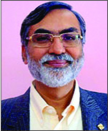Translate this page into:
Protecting health-care professionals and workers (other than COVID-19 management facilities) from contamination during COVID-19 pandemic (March 26, 2020 – India)

*Corresponding author: Purvish Parikh, Department of Precision Oncology and Research, Shalby Hospital, Mumbai, Maharashtra, India. purvish1@gmail.com
-
Received: ,
Accepted: ,
How to cite this article: Parikh P, Mehta P, Bansal S, Aggarwal S, Patel A, Batra A, et al. Protecting health-care professionals and workers (other than COVID-19 management facilities) from contamination during COVID-19 pandemic (March 26, 2020 – India). Indian J Med Sci 2020;72(1):3-4.
At present, a number of COVID-19 pandemic management guidelines are in circulation. They are rapidly evolving – just as the worldwide number of positive cases became a staggering 503,216 at 10:15 pm on March 26, 2020.
OUR ADVISORY FOR WHAT OUR COUNTRY NEEDS IN THE CURRENT SITUATION (MARCH 26, 2020)
India is in the group of countries/regions currently affected AND on the upward curve of new cases.
Health-care facilities need to gear up for inflow of large number of cases
Personnel need to be trained on how to handle the immediate future. So far, at least 6205 health care workers became positive for COVID-19 while doing their duty in managing the pandemic, in Italy alone[1]
The princess cruise evidence conforms that virus is detectable for 17 days after outbreak (without deep sanitization)[2]
Jama publication report of 138 hospitalized patients from a single institution (Zhongnan Hospital of Wuhan University) indicated that hospital-acquired transmission accounted for 41.3% of these admitted patients. (The 2003 SARS outbreak recorded almost 60% nosocomial cases occurring among health care workers)[3,4]
In Bhilwara, Rajasthan, India, all 16 positive cases are among health-care professionals in a single hospital[5]
Till date, at least 37 doctors in Italy, 9 in the Philippines, and 5 in France have died after contacting COVID-19 during their professional work.[1,6,7]
Therefore, implicating the hospital environment as a source of spread of the virus is proven.
FOLLOWING IS A PLAN ON HOW TO PREVENT THIS IN YOUR HOSPITAL/CLINIC IN INDIA
Health care workers need to be healthy and fit to look after patients even while they are at the highest risk of being infected by COVID-19. Likelihood of health care workers being infected is at least 3 times more than general population (Chinese and Italian data). How to keep them seeing patients instead of becoming patients?
In Wuhan, China, 42,000 new health care workers were brought in from other parts of their country, housed in separate quarters (away from families), and provided full CBRN biohazard PPE (full body protective covering – goggles, headgear, N95 particle filter masks, and HazMat type suits).[8]
This is not practical in India. Hence, we have to learn from how Singapore and Hong Kong prevented transmission to their health-care professionals. During the first 42 days of the outbreak, the 43 hospitals in the network tested 1275 suspected cases and treated 42 patients with confirmed COVID-19 (SARS-CoV-2). Yet, there were no nosocomial infections or infections among health care as reported by Vincent C.C. Cheng, the hospital’s infection control officer. Furthermore, in their hospital, 11 out of 413 health care workers who treated patients with confirmed infections had unprotected exposure and were in quarantine for 14 days, but none became ill.[4,9]
People should stay at home – just as our PM has appealed on TV to the nation. This saves people plus health-care professionals from getting infected
Patients with ongoing illnesses should continue with usual treatment, cancel routine medical appointments (doctor visits and investigations), and contact their respective doctors (through email or digital platforms) only in case of new significant problems
Hospitals to divide staff into teams that work in tandem on alternate days or every 3rd day (based on the number of healthy staff available, inpatient beds, and patient workload)
In hospitals/clinics, all health-care professionals to wear regular surgical masks, wear gloves, follow hand hygiene, and disinfect all surfaces in between patients
Maintain social distancing at all times – with patients and with colleagues. At least 6 ft of space in waiting area between patients, in the outpatient department between patient and doctor, and other places in between staff
If someone is contaminated/positive, the hospital/facility is NOT shut down or everyone quarantined. Only those with close contact are tested and isolated (definition of close contact used in Hong Kong was at least 15 min interaction at <6 feet without surgical mask)
Less significant contacts to be self-monitored for symptoms and temperature recorded twice a day
Goggles, headgear, N95 particle filter masks, and double gloves to be reserved for interaction with COVID-19 positive cases or for procedures where respiratory aerosols might be generated – like intubation[10]
For patients with symptoms suggestive of COVID-19 (low-grade fever, dry cough, cold, body ache, fatigue, diarrhea, and breathlessness) or family contact with COVID-19 positive case need to be dealt with as per the government directive, referred to dedicated COVID-19 health-care facility and treated by their separate team of health-care professionals.
Declaration of patient consent
Patient’s consent not required as there are no patients in this study.
References
- Available from: https://www.independent.co.uk/news/world/europe/coronavirus-latest-italy-doctors-deaths-COVID-19-symptoms-death-toll-a9427596.html [Last accessed on 2020 Mar 26]
- Available from: https://www.cnbc.com/2020/03/23/cdc-coronavirus-survived-in-princess-cruise-cabins-up-to-17-days-after-passengers-left.html [Last accessed on 2020 Mar 26]
- Available from: https://www.jwatch.org/na50873/2020/02/11/2019-novel-coronavirus-new-clinical-insights [Last accessed on 2020 Mar 26]
- Available from: https://www.medscape.com/viewarticle/926275 [Last accessed on 2020 Mar 26]
- Available from: https://www.economictimes.indiatimes.com/news/politics-and-nation/four-fresh-COVID-19-cases-in-rajasthan-total-goes-up-to-36-in-state/articleshow/74807786.cms [Last accessed on 2020 Mar 26]
- Available from: http://www.rfi.fr/en/france/20200323-hospital-staff-pay-homage-to-first-french-doctor-to-die-of-coronavirus [Last accessed on 2020 Mar 26]
- Available from: https://www.bangkokpost.com/world/1887020/nine-doctors-die-from-coronavirus-in-philippines [Last accessed on 2020 Mar 26]
- Available from: https://www.deccanherald.com/international/china-begins-withdrawal-of-medical-staff-from-wuhan-after-virus-hit-city-records-just-1-new-case-814821.html [Last accessed on 2020 Mar 26]
- Available from: https://www.asianscientist.com/2020/03/health/COVID19-measures-prevent-nosocomial-infections [Last accessed on 2020 Mar 26]
- Available from: https://www.managedhealthcareexecutive.com/news/COVID-19-case-report-no-hcws-infected-most-didnt-wear-n95-masks [Last accessed on 2020 Mar 26]





